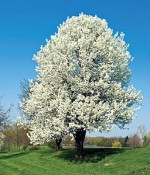 The symmetrical pyramidal form of Bradford pears is so picturesque that homeowners find it difficult to resist planting them. Their early spring bloom on the perfectly shaped trees is so outstanding the people ignore the fact that these trees are very susceptible to breakage by wind and ice storms so rarely reach maturity. In addition the flowers have an undesirable odor but even this does not deter people from treasuring the trees in their landscape. The trees are also considered invasive so perhaps it would be wise to consider substitutes such as serviceberry, dogwood, American plum, white redbud, flowering crabapple, or fringe tree.
The symmetrical pyramidal form of Bradford pears is so picturesque that homeowners find it difficult to resist planting them. Their early spring bloom on the perfectly shaped trees is so outstanding the people ignore the fact that these trees are very susceptible to breakage by wind and ice storms so rarely reach maturity. In addition the flowers have an undesirable odor but even this does not deter people from treasuring the trees in their landscape. The trees are also considered invasive so perhaps it would be wise to consider substitutes such as serviceberry, dogwood, American plum, white redbud, flowering crabapple, or fringe tree.
Type: Deciduous tree.
Outstanding Feature: Pyramidal form; early spring flowers; orange to red autumn color.
Form: Pyramidal.
Growth Rate: Rapid
Bloom: Clusters of white flowers 1” in diameter in early spring.
Size: 60’ H x 20-30’ W.
Light: Full sun.
Soil: Tolerates a wide variety of soil types but needs good drainage.
Fertilizer: Apply 2 cups /100 square feet of a slow release fertilizer, 12-6-6 for example, in April every three years.
Hardiness: Zones 4-9.
Care: Prune in summer or late winter. Remove backened twigs any time of year.
Pests and Diseases: Few pests or diseases but very susceptible to breakage by ice or wind. Remove double leaders to reduce branch-splitting damage.
Propagation: Seed (stratify 60-90 days)
Comments: Other cultivars are available but tend to be more susceptible to fire blight while being less susceptible to wind and ice damage. ‘Chanticleer’ is less susceptible to both problems but has a more upright form.
